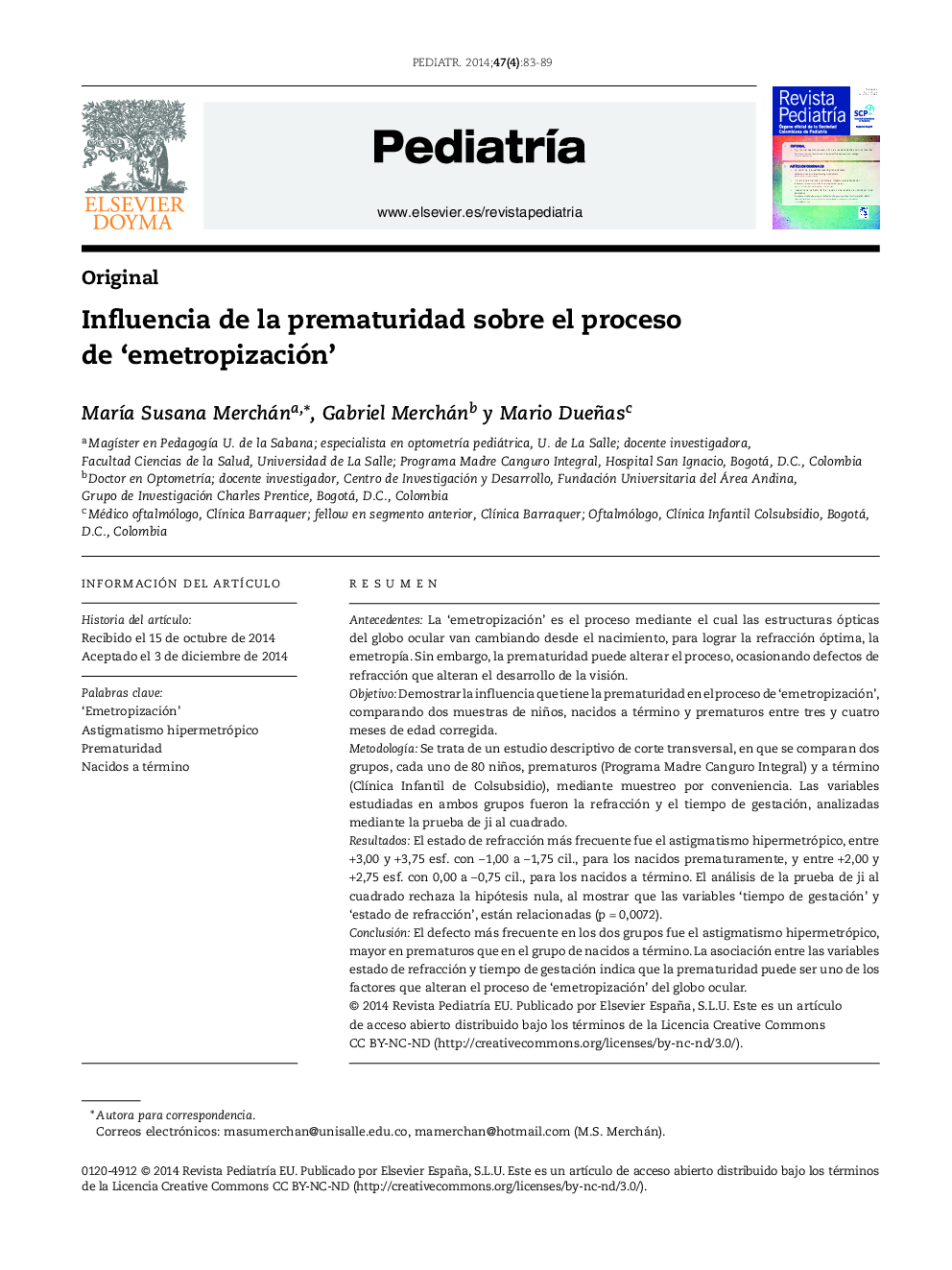| Article ID | Journal | Published Year | Pages | File Type |
|---|---|---|---|---|
| 4173485 | Pediatría | 2014 | 7 Pages |
RESUMENAntecedentesLa ‘emetropización’ es el proceso mediante el cual las estructuras ópticas del globo ocular van cambiando desde el nacimiento, para lograr la refracción óptima, la emetropía. Sin embargo, la prematuridad puede alterar el proceso, ocasionando defectos de refracción que alteran el desarrollo de la visión.ObjetivoDemostrar la influencia que tiene la prematuridad en el proceso de ‘emetropización’, comparando dos muestras de niños, nacidos a término y prematuros entre tres y cuatro meses de edad corregida.MetodologíaSe trata de un estudio descriptivo de corte transversal, en que se comparan dos grupos, cada uno de 80 niños, prematuros (Programa Madre Canguro Integral) y a término (Clínica Infantil de Colsubsidio), mediante muestreo por conveniencia. Las variables estudiadas en ambos grupos fueron la refracción y el tiempo de gestación, analizadas mediante la prueba de ji al cuadrado.ResultadosEl estado de refracción más frecuente fue el astigmatismo hipermetrópico, entre + 3,00 y + 3,75 esf. con − 1,00 a − 1,75 cil., para los nacidos prematuramente, y entre + 2,00 y + 2,75 esf. con 0,00 a − 0,75 cil., para los nacidos a término. El análisis de la prueba de ji al cuadrado rechaza la hipótesis nula, al mostrar que las variables ‘tiempo de gestación’ y ‘estado de refracción’, están relacionadas (p = 0,0072).ConclusiónEl defecto más frecuente en los dos grupos fue el astigmatismo hipermetrópico, mayor en prematuros que en el grupo de nacidos a término. La asociación entre las variables estado de refracción y tiempo de gestación indica que la prematuridad puede ser uno de los factores que alteran el proceso de ‘emetropización’ del globo ocular.
ABSTRACTBackground‘Emmetropization’ is the process of change by the eyeball optical structures that takes place from birth in order to achieve an optimal refractive state, emmetropia. However, prematurity can alter this process, causing refractive defects that alter the development of vision.ObjectiveThe present study aims to show the influence of prematurity on the process of ‘emmetropization’ by comparing a sample of 80 children of 3 to 4 months of age born prematurely with a sample of 80 children born at full-term.MethodsA descriptive cross-sectional study was conducted comparing two groups, preterm infants (Integral Kangaroo Mother Program) and term infants (Children’s Clinic Colsubsidio) each with 80 children, using selected convenience sampling. The variables studied in both groups were: refractive status and gestation period, analyzed by the chi square test.ResultsThe most common refractive error was hyperopic astigmatism (+ 3.00 to + 3.75 sph., − 1.00 to − 1.75 with cyl.) for those born prematurely and (+ 2.00 to + 2.75 sph. with 0.00 to − 0.75 cyl.) for term infants. Chi-square analysis rejected the null hypothesis that the variables showing gestational age and refractive state were related (P = .0072).ConclusionThe most common defect for the two groups was hyperopic astigmatism, being higher in the preterm group than in term infants group. The association between the variables, refractive status and gestational age, indicate that prematurity can be one of the factors that alter the process of ‘emmetropization’ of the eyeball.
